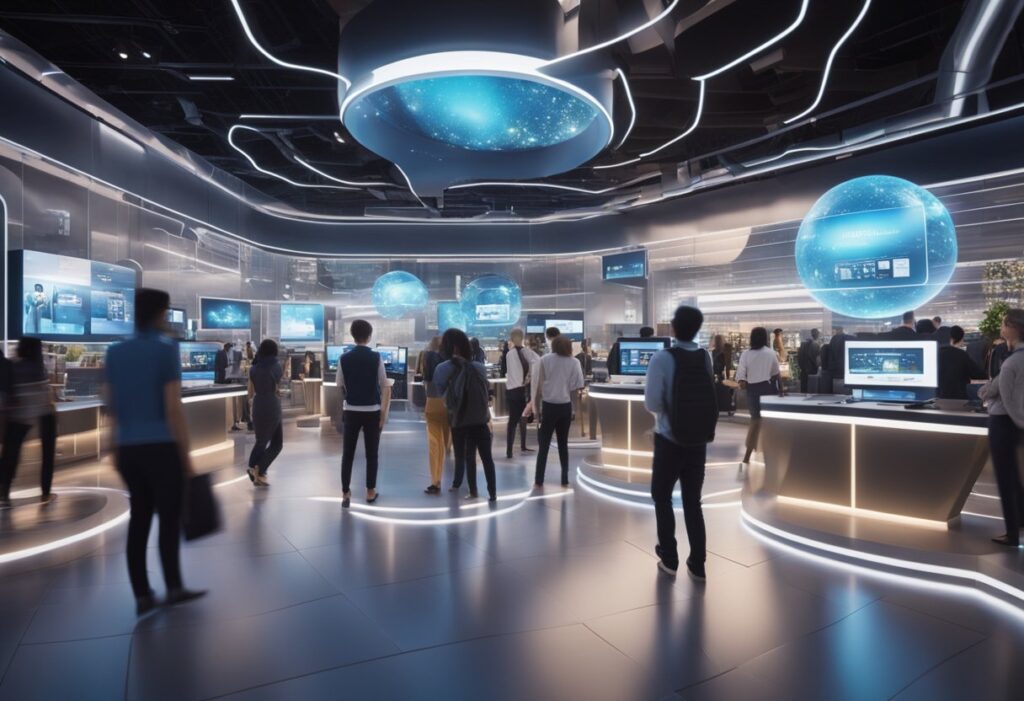The Metaverse Retail is a new concept that has been gaining popularity in recent years. It is a virtual world that is created by the convergence of physical and digital spaces. The metaverse has the potential to revolutionize the way people interact with each other, and it is also expected to have a significant impact on the retail industry.
The metaverse is expected to change the retail industry in several ways. One of the most significant changes is the way consumers will shop. In the metaverse, consumers will be able to interact with products in a way that is not possible in the physical world. They will be able to see products in 3D, try them on virtually, and even customize them to their liking. This will make the shopping experience more engaging and personalized, which is something that many consumers are looking for.
Technology will play a significant role in the development of the metaverse. Retailers will need to invest in new technologies to create a seamless shopping experience for consumers. This includes virtual reality, augmented reality, and artificial intelligence. Retailers will also need to develop new business models to take advantage of the opportunities presented by the metaverse.
Evolution of Retail in the Metaverse

The metaverse is revolutionizing the retail industry by providing a virtual platform for customers to shop and interact with products. The shift from physical to virtual retail has been gradual, but it is now gaining momentum as more retailers embrace the concept.
10 Retail stores in the metaverse
- Nike: Created Nikeland on Roblox, a virtual space where users can play games, design their own avatars, and purchase virtual Nike gear. This initiative allows Nike to engage with a younger audience in a digital environment.
- Gucci: Launched the Gucci Garden experience on Roblox, which is an interactive virtual world where users can explore and buy limited edition virtual Gucci products. It’s a way for Gucci to blend the lines between virtual and physical fashion.
- Forever 21: Opened a virtual store on Roblox, allowing users to buy and wear digital fashion items on their avatars. This extends the brand’s reach into the digital realm and targets the gaming community.
- Vans: Created Vans World on Roblox, an interactive skatepark where players can try on Vans shoes and apparel, skate around, and engage with the brand in a fun, virtual setting.
- Burberry: Partnered with games like Honor of Kings to offer in-game Burberry outfits for characters, tapping into the lucrative market of in-game purchases and brand collaborations.
- Coca-Cola: Sold branded virtual wearables and even a “loot box” on the Decentraland platform, experimenting with new ways of digital merchandising and brand engagement.
- Hyundai: Created a virtual showroom in the metaverse to showcase their latest models and innovations, providing an immersive brand experience beyond traditional showrooms.
- Louis Vuitton: Launched a mobile game with embedded NFTs to celebrate the brand’s 200th anniversary, blending gaming with luxury fashion and collectibles.
- Adidas: Entered the metaverse through partnerships with NFT projects and by purchasing a virtual plot of land in The Sandbox game, aiming to create interactive experiences and virtual goods.
- Samsung: Opened a virtual version of its New York flagship store in Decentraland, allowing visitors to browse products and engage with the brand in a 3D environment.
From Physical to Virtual: The Shift
The shift from physical to virtual retail has been driven by the increasing popularity of virtual reality (VR) and augmented reality (AR) technologies. These technologies have made it possible for retailers to create immersive shopping experiences that go beyond the limitations of the physical world.
Virtual retail allows customers to explore products in a virtual environment that mimics the physical world. It provides a more engaging and interactive shopping experience that allows customers to interact with products in a way that was not possible before.
The Role of AR and VR in Retail
AR and VR technologies have played a significant role in the evolution of retail in the metaverse. AR technology allows customers to view products in their physical environment, while VR technology provides an immersive shopping experience that transports customers to a virtual environment.
The use of AR and VR technologies in retail has been on the rise in recent years, with many retailers using these technologies to create interactive experiences for their customers. For example, some retailers are using AR technology to allow customers to try on clothes virtually, while others are using VR technology to provide a virtual tour of their stores.
The metaverse is revolutionizing the retail industry by providing a virtual platform for customers to shop and interact with products. The shift from physical to virtual retail has been driven by the increasing popularity of AR and VR technologies, which have made it possible for retailers to create immersive shopping experiences that go beyond the limitations of the physical world.
Branding and Consumer Engagement

Creating Immersive Brand Experiences
In the metaverse, brands have the opportunity to create immersive experiences that go beyond traditional marketing methods. They can create virtual stores, host events, and provide interactive experiences that allow customers to engage with their brand in new and exciting ways. These experiences can be personalized to the individual customer, making them feel valued and appreciated.
To create an immersive brand experience, companies can use avatars and AI to interact with customers. Avatars can be designed to represent the brand, providing a consistent image and message across all interactions. AI can be used to personalize the experience, providing recommendations based on the customer’s preferences and past behavior.
Enhancing Customer Experience with AI and Avatars
AI and avatars can also be used to enhance the overall customer experience in the metaverse. AI can be used to provide personalized recommendations, making it easier for customers to find what they are looking for. Avatars can be used to provide customer service, answering questions and providing assistance in real-time.
Personalization is key to creating a positive customer experience. By using AI and avatars, companies can provide a personalized experience that makes customers feel valued and appreciated. This can lead to increased engagement and loyalty.
The metaverse provides a unique opportunity for brands to create immersive experiences and enhance customer engagement. By using avatars and AI, companies can provide personalized experiences that make customers feel valued and appreciated. This can lead to increased engagement and loyalty, ultimately resulting in increased sales and revenue.
Monetization and Business Models

Selling Virtual Goods and Services
One of the most popular ways to monetize in the metaverse is by selling virtual goods and services. These can range from digital clothing and accessories to virtual real estate and even experiences. By creating unique and desirable items, businesses can tap into the growing demand for personalized and immersive experiences in the metaverse.
One of the key advantages of selling virtual goods is that they can be easily replicated and distributed, making it possible to sell the same item to multiple customers without incurring additional production costs. Virtual goods can be easily customized and personalized, creating a sense of exclusivity that can drive demand and increase prices.
Innovative Revenue Streams in the Metaverse
In addition to selling virtual goods and services, businesses can also explore innovative revenue streams in the metaverse. One example is the use of non-fungible tokens (NFTs), which can be used to represent unique digital assets such as artwork, music, and even virtual real estate. By leveraging NFTs, businesses can create a new market for digital assets and generate revenue through the sale and transfer of these assets.
Another example of an innovative revenue stream is the use of digital twins, which are digital representations of physical objects or spaces. By creating digital twins of real-world objects, businesses can offer virtual experiences and services that complement their physical offerings. For example, a clothing retailer could create a digital twin of their store, allowing customers to browse and purchase items in a virtual environment.
The metaverse offers a range of opportunities for businesses to monetize and generate revenue through the sale of virtual goods and services, as well as through innovative revenue streams such as NFTs and digital twins. By staying up-to-date with the latest trends and technologies, businesses can position themselves for success in this rapidly evolving landscape.
Challenges and Future Outlook

Overcoming Technical and Adoption Hurdles
As with any new technology, the metaverse presents several technical and adoption hurdles that must be overcome before it can become a mainstream retail platform. One of the biggest challenges is hardware. The current hardware required to access the metaverse is expensive and not widely available. This limits the number of users who can access the platform, which in turn limits its potential for growth.
Another challenge is software. The metaverse requires a complex software infrastructure to function properly, and this infrastructure is still in its early stages of development.
There are also concerns about the security of the metaverse, particularly with regards to blockchain technology. These challenges must be addressed before the metaverse can become a viable platform for retailers.
Predicting Growth and Trends
Despite these challenges, there is no doubt that the metaverse has the potential to transform the retail industry. As technology improves and the cost of hardware decreases, more consumers will be able to access the platform, creating new opportunities for retailers to engage with their customers.
One of the most exciting aspects of the metaverse is its potential for innovation. Retailers will be able to experiment with new products and services in a virtual environment, without the costs and risks associated with physical stores. This will lead to new growth opportunities and trends in the retail industry.
The metaverse presents both challenges and opportunities for the future of retail. While there are technical and adoption hurdles that must be overcome, the potential for growth and innovation is significant. As the technology continues to develop, retailers will need to stay up-to-date with the latest trends and best practices in order to take advantage of this new platform.
Frequently Asked Questions
What is metaverse retailing?
Metaverse retailing refers to the integration of virtual reality technology with traditional retail practices. This creates an immersive shopping experience that allows customers to interact with products and services in a virtual environment.
What are the 3 pillars of the retail metaverse?
The three pillars of the retail metaverse are immersion, personalization, and socialization. Immersion refers to the ability for customers to fully engage with products and services in a virtual environment. Personalization involves tailoring the shopping experience to the individual customer’s preferences and needs. Socialization refers to the ability for customers to interact with other shoppers and form communities within the metaverse.
What are the challenges of metaverse retail?
One of the biggest challenges of metaverse retail is the need for advanced technology and infrastructure to support the virtual environment. Retailers must find ways to balance the benefits of personalization and socialization with the need to protect customer privacy and data.
How are products showcased and sold within the metaverse?
Products are showcased and sold within the metaverse through virtual storefronts and 3D product displays. Customers can interact with these displays and make purchases using virtual currency or real-world payment methods.
Which companies are leading the integration of retail into the metaverse?
Several companies are leading the integration of retail into the metaverse, including Amazon, Walmart, and Nike. Virtual marketplaces such as Decentraland and The Sandbox are creating new opportunities for retailers to reach customers in the metaverse.
What strategies are retailers adopting to succeed in the metaverse?
Retailers are adopting a variety of strategies to succeed in the metaverse, including creating immersive shopping experiences, leveraging data and analytics to personalize the shopping experience, and building communities of loyal customers within the metaverse.
What are the primary benefits for retailers operating in the metaverse?
The primary benefits for retailers operating in the metaverse include increased customer engagement, access to new markets and demographics, and the ability to collect and analyze large amounts of customer data.
How does e-commerce function differently in the metaverse compared to traditional platforms?
In the metaverse, e-commerce functions differently than traditional platforms in that it is more immersive and interactive. Customers can interact with products and services in a virtual environment, and retailers can leverage data and analytics to personalize the shopping experience.
What are the main challenges retailers face when entering the metaverse marketplace?
The main challenges retailers face when entering the metaverse marketplace include the need for advanced technology and infrastructure, the need to balance personalization and socialization with customer privacy and data protection, and the need to adapt to new customer behaviors and expectations within the metaverse.














